Cytauxzoonosis in cats is a lesser-known disease caused by Cytauxzooan felis, a protozoan. C. felis is transmitted through tick bites (American dog tick and Lone-star tick). Although it is a common disease in the US among domestic cats, the number of cytauxzoonosis cases among cats is steadily increasing in India. This disease needs urgent medical attention and a visit to a cat clinic near you.
The reason for the steady rise of cytauxzoonosis in cats in India can be partly attributed to the lack of population control and partly due to the lack of external parasite control measures taken by cat parents.
Cats are not a natural host for Cytauxzoon felis. Cats are usually considered to be an aberrant or end of the cycle host who get infected “by chance” through the bite of an infected dog tick. Thankfully, cats cannot become infected by C felis from the bite of another cat or by ingesting an infected tick.
Signs of cytauxzoonosis in cats
The clinical signs of cytauxzoonosis in cats typically develop between 7 and 14 days after the tick bite.
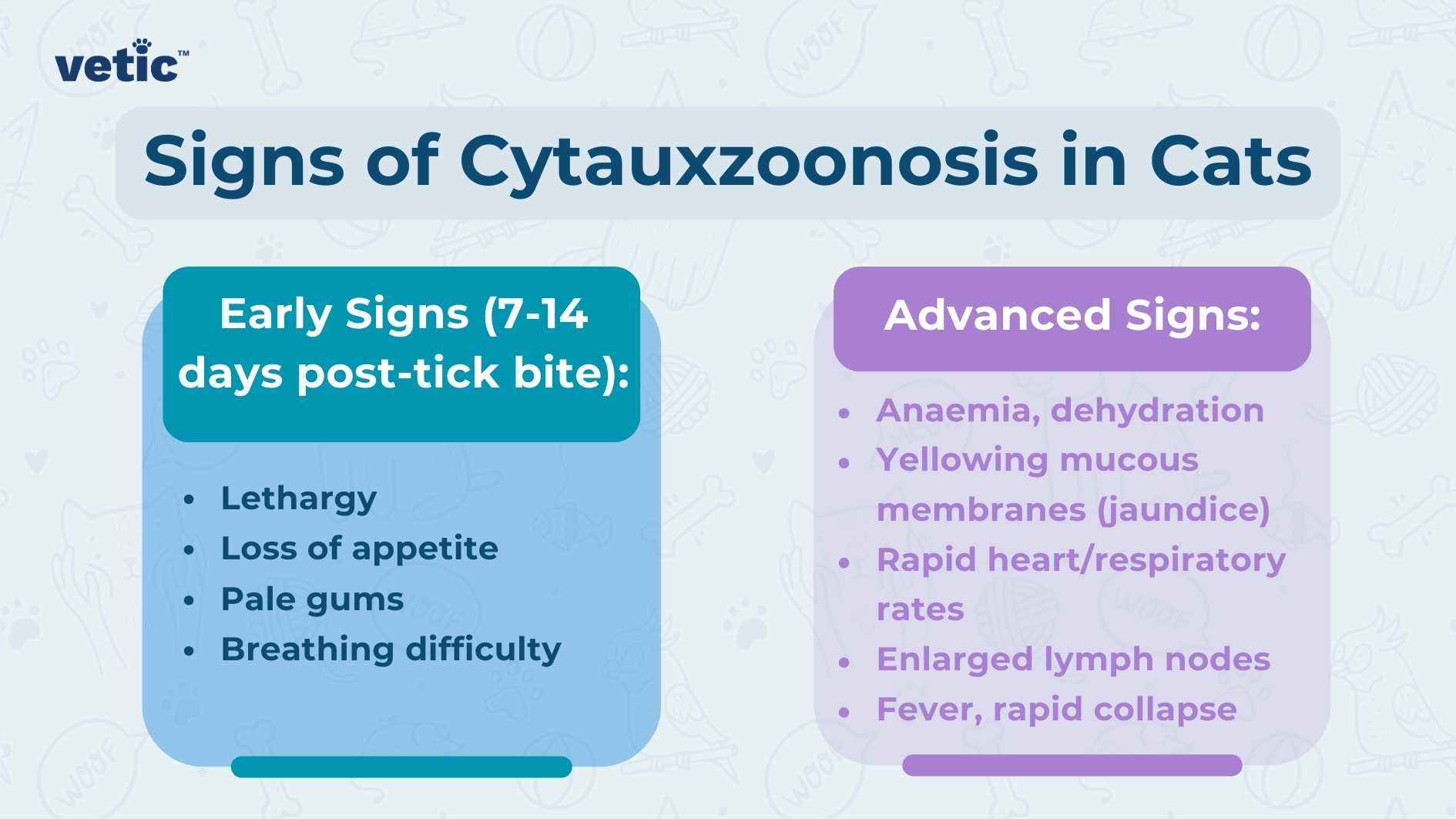
The early signs of cytauxzoonosis in cats are non-specific. They may include –
- Lethargy
- Loss of appetite
- Pale gums
- Breathing difficulty
Further physical examination of the cat infected with cytauxzoonosis may reveal –
- Anaemia
- Dehydration
- Yellowing mucous membrane
- Fever
- Rapid heart rate
- Rapid respiratory rate
- Enlarged lymph nodes
The disease is aggressive since it is carried through the RBCs and they can affect multiple organs. Cytauxzoonosis also causes enlargement of the spleen and liver, and lung damage (pulmonary edema) within days of the initial signs, if left untreated.
Sadly, once the cat spikes a fever, complete collapse may occur within 3-4 days. However, that only occurs without timely diagnosis and treatment.
So, if your cat is suddenly showing a drop in energy level and loss of appetite, you should get a complete blood test done along with blood smear and rtPCR to determine the cause.
In the last stages, the cat may become hypothermic (body temperature lower than 100-degrees fahrenheit), have frequent seizures and lapse into a coma followed by complete collapse.
How does cytauxzoonosis cause disease in cats?
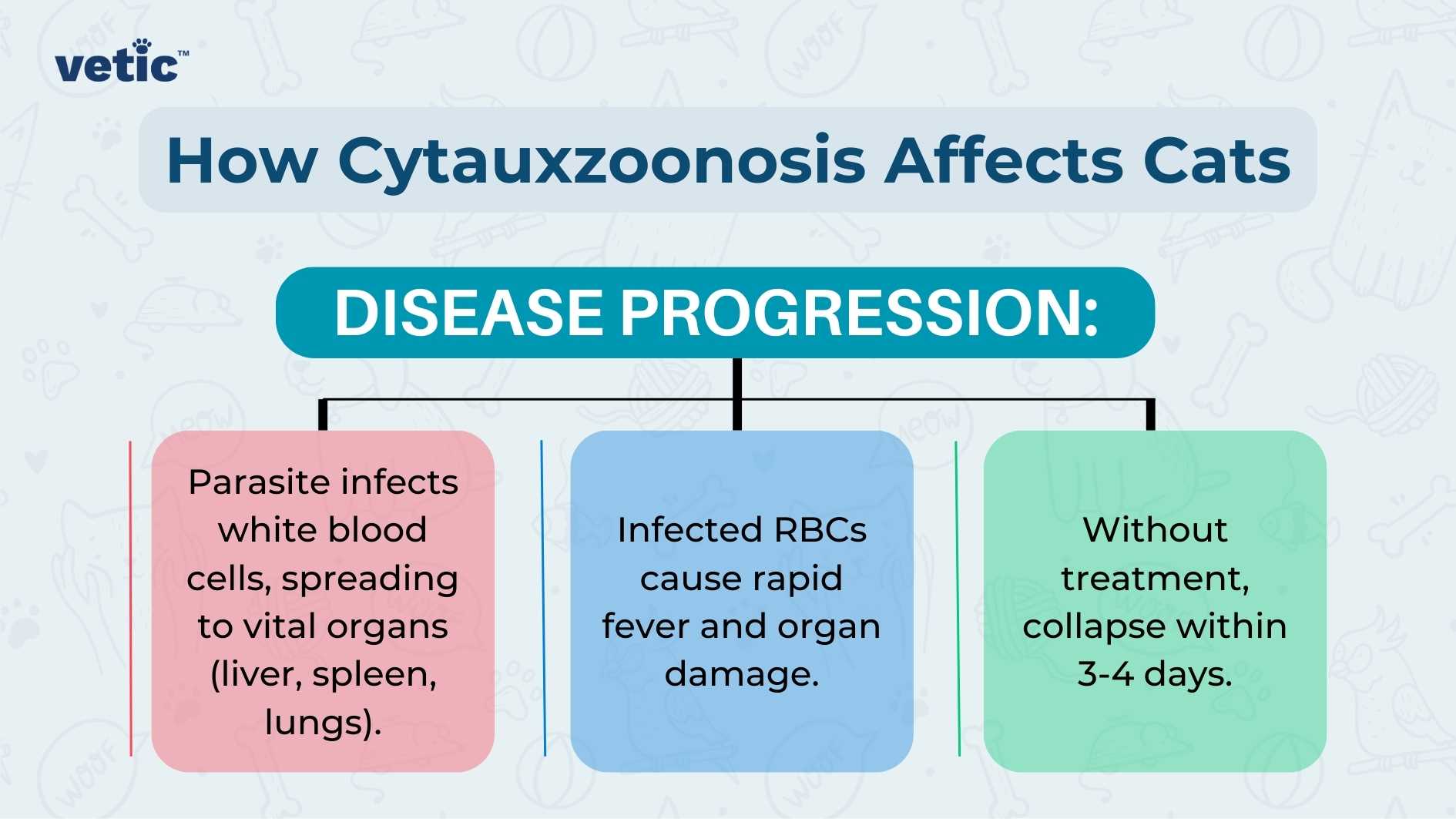
After C. felis is introduced into the cat’s blood from the tick bite, the small, premature form of the parasite (sporozoites) infect the white blood cells (macrophages). Inside the macrophages, they reproduce to form a larger cell called the schizonts. These larger schizonts travel to almost all organs (spleen, liver, bone marrow and lung) via the bloodstream. They can clog the blood vessels leading to vital organs, stopping blood flow leading to necrosis and death of vital tissue.
When these large cells or schizonts burst they release smaller parasitic cells called piroplasms that infect the RBCs (Red Blood Cells). Piroplasms remain in the RBC, but an acute rise of body temperature and fall of WBCs have been related to an increasing number of piroplasms in the RBC.
Since it is impossible to rid the RBCs of the Cytozoon piroplasms, the cats that survive always carry the parasite in their blood but remain asymptomatic. Interestingly, most feline survivors of cytauxzoonosis have remained immune to the infection.
How is cytauxzoonosis diagnosed in cats?
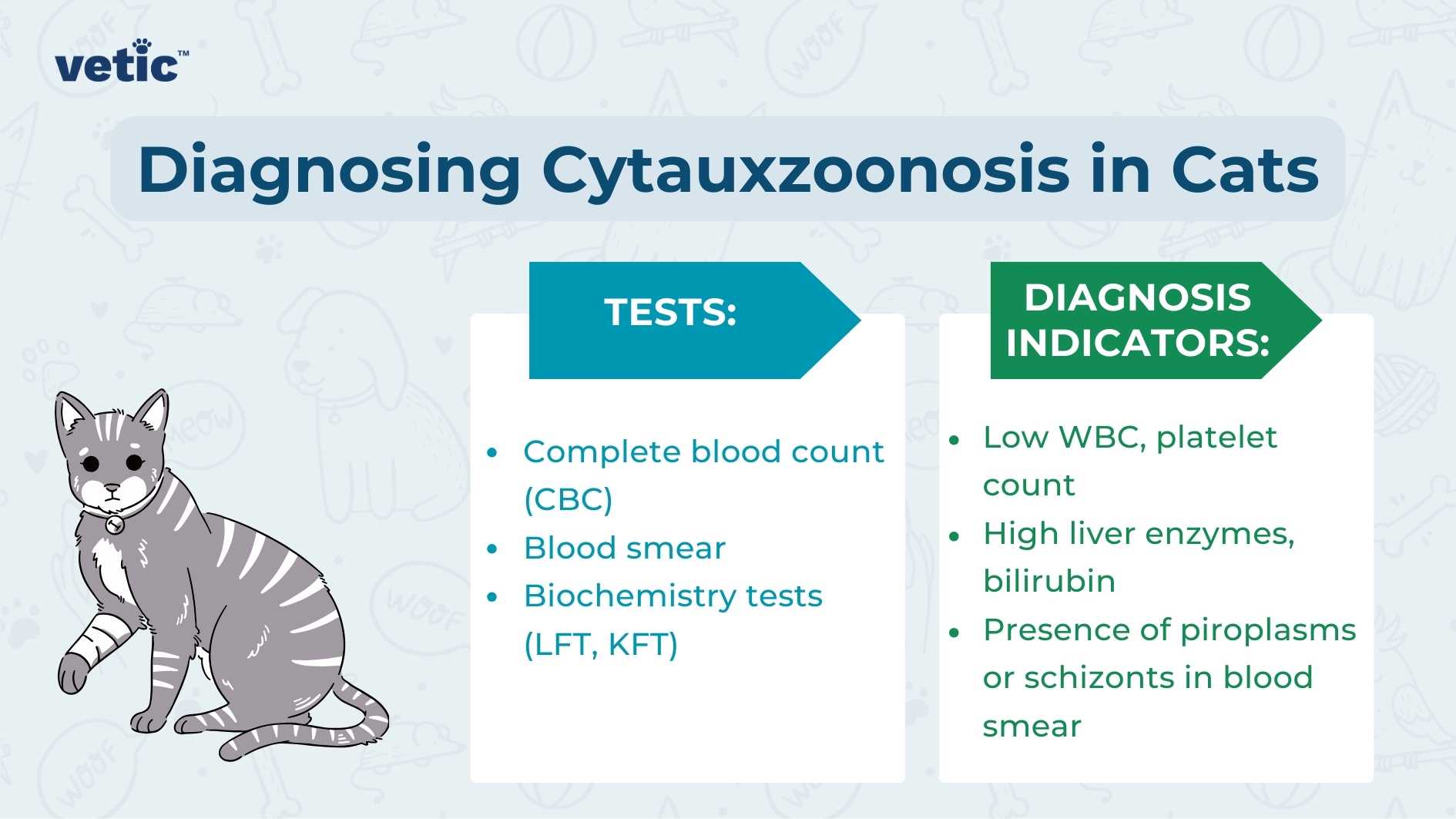
Diagnosing cytauxzoonosis in cats requires blood tests.
- Complete blood count (CBC)
- A blood smear
- Biochemistry tests (LFT, KFT)
The CBC of a cat with cytauxzoonosis will slow low WBC and platelet count along with other signs of anaemia.
Biochemistry tests often reveal a higher than normal bilirubin level (hyperbilirubinemia) and a low albumin level (hypoalbuminemia). Other abnormalities can include high liver enzymes in the blood, high blood urea-nitrogen and creatinine levels.
Depending on the stage of infection, the microscopic study of the blood smear can reveal the presence of piroplasms and schizonts. These are parasitic forms and are easily recognizable in blood smears from the stain they absorb.
However, if your cat’s blood sample doesn’t show the presence of piroplasms or schizonts, they might require a fine needle aspiration from their lymph nodes for confirmed diagnosis.
Since the signs of cytauxzoonosis in cats are similar to other infections, a physical examination is never enough for a conclusive diagnosis.
What is the treatment for cytauxzoonosis in cats?
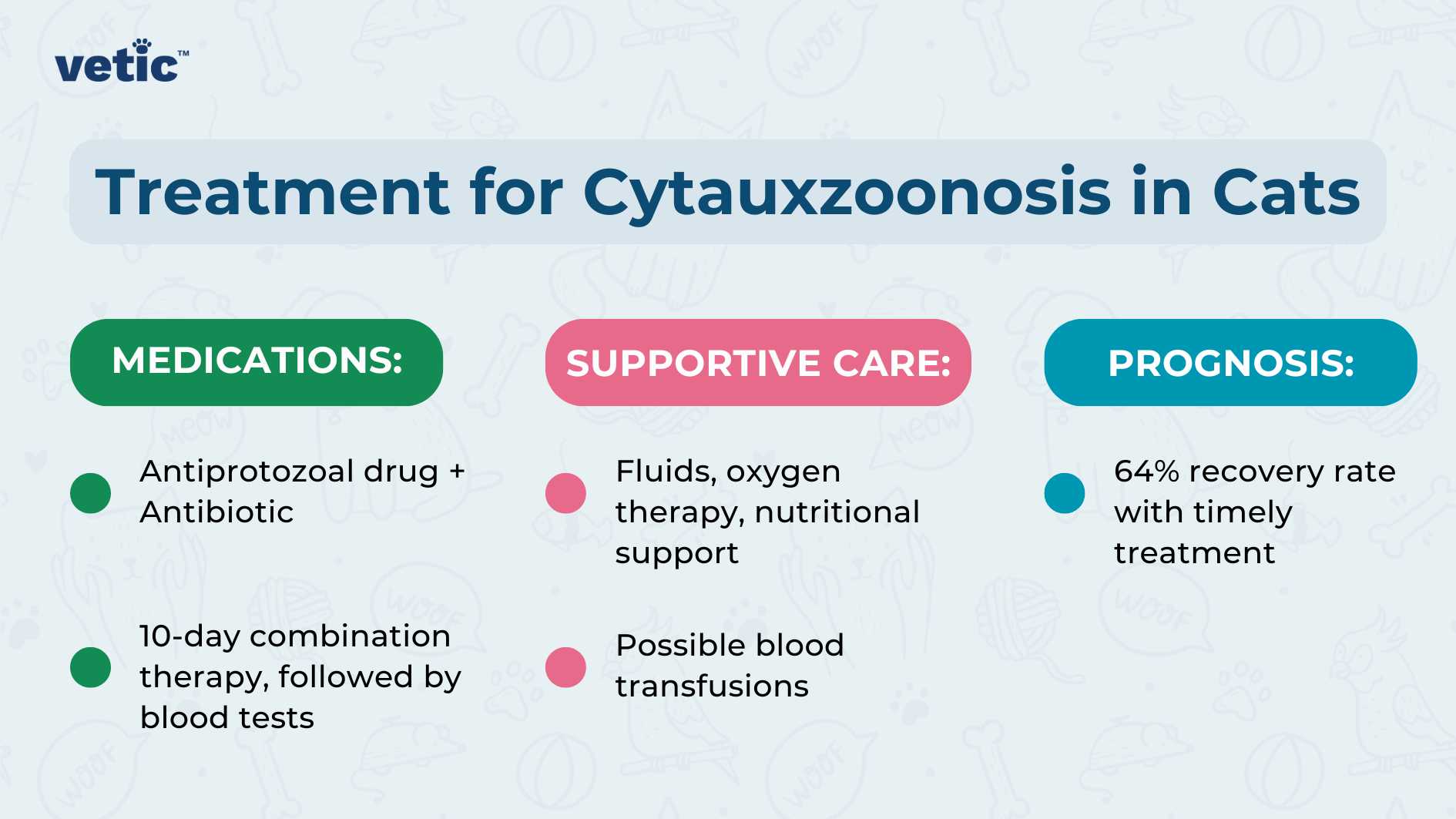
The treatment for cytauxzoonosis in cats involves the use of an antiprotozoal drug in combination with an antibiotic.
Although both drugs are widely available, you need to be cautious since at least one of them can cause serious side effects, when not given the correct dose and frequency.
The combination therapy typically lasts 10 days after which your vet will prescribe follow-up blood tests to ensure that your cat is free from the active infection.
The treatment should be started as soon as you receive a diagnosis since the disease progresses very aggressively!
Sometimes, severely sick cats require supportive care including fluids, nutritional support, oxygen therapy and blood transfusion(s). So, if your cat does have cytauxzoonosis, you should begin looking for holistic veterinary care providers who have all the necessary life-saving services under one roof.
Can a cat with cytauxzoonosis survive?
When a cat receives proper treatment and supportive care for cytauxzoonosis, they can recover. Currently, the recovery rate of cats with cytauxzoonosis after receiving timely and correct treatment is close to 64%.
The mortality of infected cats without any treatment is nearly 100%.
However, cats that survive the infection will remain a reservoir for Cytauxzoon felis for the rest of their lives. So, it’s important to keep them indoors so as to not spread the disease.
At the same time, mention their infection history to the veterinarian every time you visit, so they can also take precautionary measures while vaccinating, drawing blood or cleaning a wound.
How can you prevent your cat from getting cytauxzoonosis?
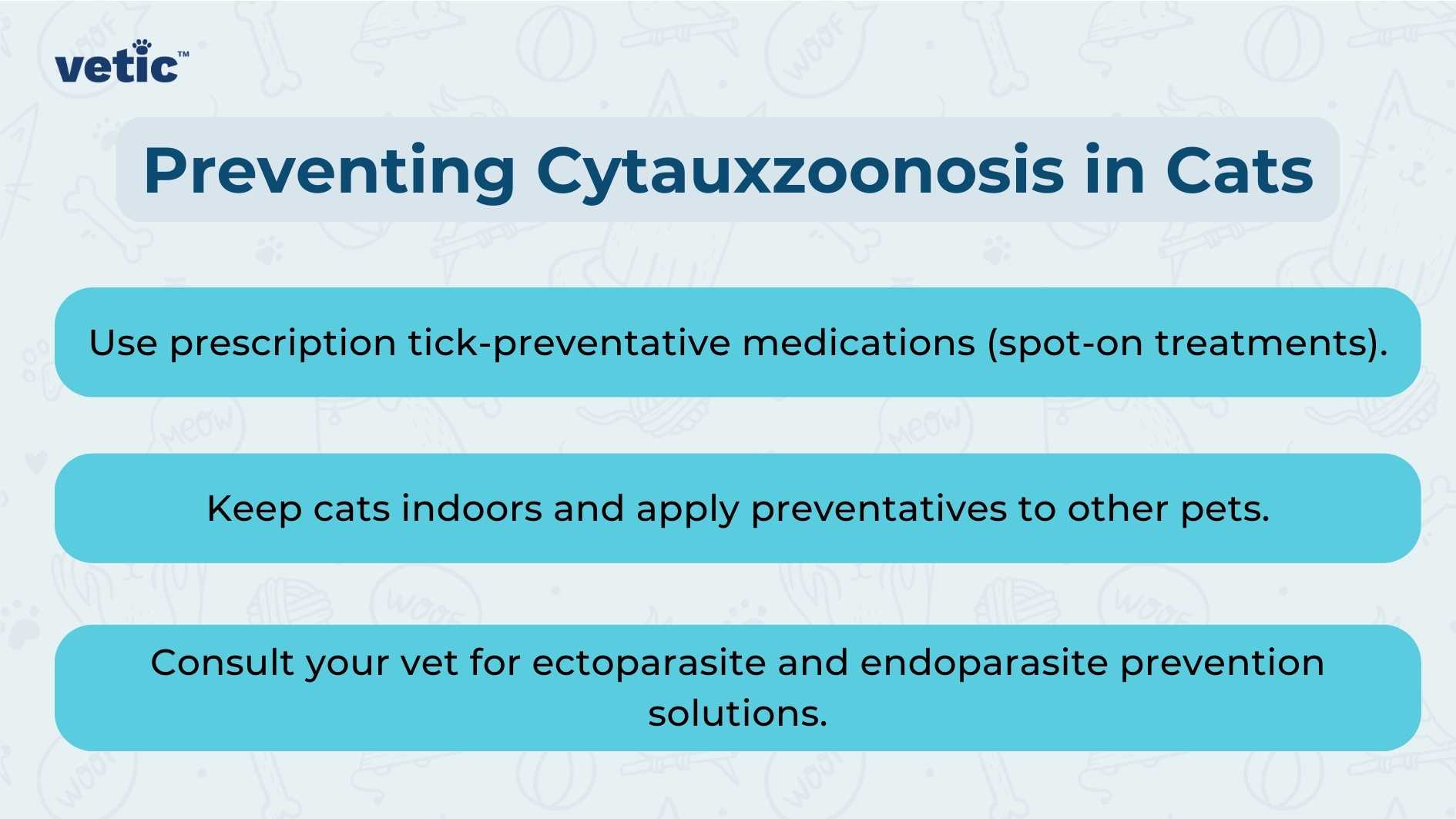
You can always rely on prescription tick preventative medication (spot-on). In India, we do not yet have anti-tick or anti-flea chewables for cats, but we have broadspectrum spot-on solutions that provide protection against at least 10 parasites for a month.
Speak to a veterinarian about ectoparasite and endoparasite preventives that you can apply by yourself at home. If you have other pets including dogs, you need to get them on a broad-spectrum tick, flea and other parasite preventives as well.

